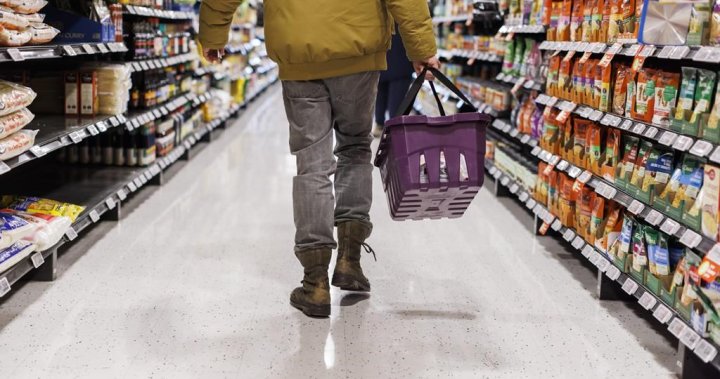Food banks in Canada are being pushed to the brink with high demand and donations not keeping pace. Experts say it’s unsustainable.
The last four years have been financially tumultuous for Canadians. A global pandemic and rampant inflation have led to high grocery prices, with more and more people finding themselves unable to afford the basics.
But what happens when donations to help are not keeping up with demand?
“The word that I hear often with food banks across Canada is ‘unsustainable,’” says Kirstin Beardsley, Food Banks Canada CEO.
“When you see the rates of growth that we’ve seen and the strain, the amount of donations that we need to see coming through the door either stagnate or not keep up the pace, this is not a sustainable situation.”
How the cost of living is impacting donations and demand
Beardsley says that although food banks have always worked hard to meet the need, it’s becoming more challenging to get by.
“While folks and Canadians across the country continue to be generous, we are starting to hear that it’s not enough to meet the growing levels of demand that our food banks are facing,” Beardsley says.
“People’s budgets are stretched. They don’t have the space in their own budgets to make that extra donation because they’re really struggling to make ends meet.”
A 2023 report from Canada Helps found that 57.3 per cent of charities cannot meet current levels of demand and that 31.5 per cent of charities raised less money than the year before.
The report also showed that the number of Canadians relying on charities for basic needs was up eight percentage points in nine months to a total of 22 per cent of all Canadians.
Unlike other social services, food banks are primarily community-funded, with the majority of support coming from donors and collections by community groups and local businesses.
To give people a sense of just how bad it’s gotten, Beardsley compared the impacts of the 2008 recession with the pandemic. During and after the recession, she said food banks on average saw a 30 per cent increase in demand for services. Since the COVID-19 pandemic and rising inflation, Beardsley says 2023 data shows a roughly 80 per cent increase in demand for services. It’s likely to be higher once the 2024 numbers are collected, she added.
“We haven’t seen this rate of growth since food banks have been collecting data,” she says.
The email you need for the day’s
top news stories from Canada and around the world.
“Food banks tend to deal with economic challenges for a much longer stretch than you see represented in federal data or statistics. So the economy gets better, which is great, but food banks are still dealing with that long tail of need as people get back on their feet and are able to support themselves.”
The recent spring food drive in Barrie, Ont., is one example of the strain on local food banks.
The Barrie Food Bank’s executive director says that although they managed to meet their food collection goal, they were $100,000 short on their financial goal.
“The food donations are obviously very helpful, but the financial donations are also really important because that’s what we use to buy perishable items like meat, milk, margarine, eggs. Those are highly valued items for the clients,” Sharon Palmer says.
Barrie Food Bank launched its spring food drive Friday. The drive continues until March 31.
Handout/Barrie Food Bank
While Palmer feels an early Easter did not help collection efforts, she believes donation fatigue is a factor.
“Donations have reduced to where people are not donating, so that’s affecting the whole industry,” she says. “So we’ve gone through the pandemic, we’ve gone through this period of high inflation that’s affecting this whole social sector and a lot of charities, so there’s been a lot of asks out there in the marketplace, and so people only can do so much.”
Palmer says that over the last few months, demand for their services has reached a peak and is staying around 7,000 people each month. She says that while it’s good to see the numbers stop rising, that is also “an awful lot of people who are needing food support on a monthly basis.”
“It’s a pretty high level of food and financial donations we need to be able to meet that need. To be realistic, we have had to cut back a little on some of the quantities of items just to stay in our budget.”
With the cost of living leading to more people needing their services, Palmer says single people are making up one of the biggest groups they see because they have to pay all their expenses on their own.
“There are still new people coming in for the first time and having to use the food bank. It’s always difficult for people to make that decision, but we’re glad that they do because we know that if we can give them a little help and get them through a tough period, a lot of times, they just get back on their feet,” Palmer says.
“We have this old board member who used to say there’s just too much month at the end of the money when your money runs out.”
Beardsley says with kids’ lunches to build, gas to buy to get to work and rent to pay, it’s hard to afford it all these days.
“It’s impossible to make it all work when the income’s not enough and the expenses are too high.”
To combat the drop in donations, Beardsley and Palmer say food banks are relying more and more on food recovery programs, where they divert food from grocery stores, food suppliers and farmers that will not sell before spoiling.
Palmer says this allows them to quickly deliver perishable products with a short shelf life to those in need.
Despite efforts to keep up with the high demand, experts say more work needs to be done.
Addressing the root cause
When asked if the federal and provincial governments should support food banks more, Palmer said it would help more if they looked at how to prevent people from needing to go in the first place.
“I’d rather have policies that help encourage employment, and that would create more availability of housing,” she says.
Palmer says one area that could help curb demand is providing more financial support for people on government assistance programs.
She says people who rely on government assistance for an injury or disability are receiving far less money than they need to cover their everyday living expenses, with the majority or all going towards rent.
She notes that another key demographic they continue to see more of is people without homes.
“Until we have more housing resources available, I don’t think that segment is going to reduce at all,” Palmer says.
The CEO of Food Banks Canada agrees, encouraging those who aren’t in a position to donate to advocate for change instead.
“Talk to elected officials about the need to invest in making sure that low-income folks have higher incomes, that we are addressing the affordability crisis in Canada, and that governments take action,” Beardsley says.
“Our vision really is — and we believe in it — a Canada where no one goes hungry.”





